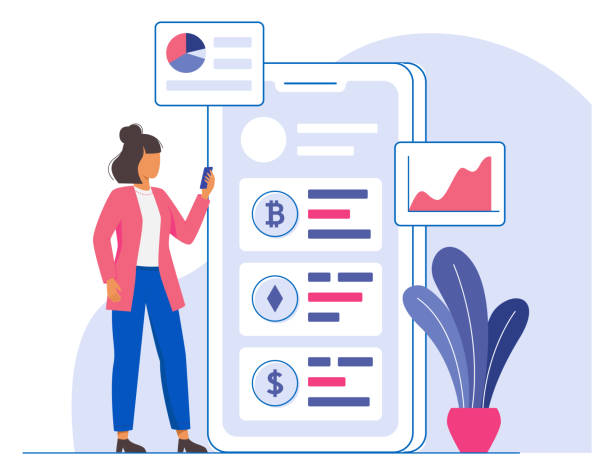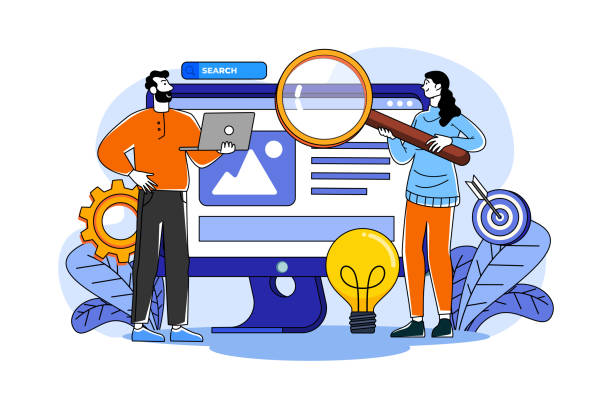Introduction to Fast Website Design and Its Importance

In today’s fast-paced world, website speed is not just a competitive advantage, but an undeniable necessity.
In this #explanatory chapter, we delve into why fast website design is of crucial importance.
User experience is directly affected by page loading speed.
If a website is slow, users will abandon it without hesitation and move to your competitors.
Studies have shown that every second of delay in loading can significantly increase the Bounce Rate and decrease the Conversion Rate.
In addition to user experience, website speed is a key factor in Search Engine Optimization (SEO).
Major search engines like Google prefer faster websites in their search results rankings.
This means that a high-speed website has a better chance of being seen and attracting organic traffic.
In fact, speed is recognized as one of the most important ranking signals in Google’s algorithms.
Therefore, investing in fast website design is an investment in the success of your online business.
In the following, we will cover technical details and practical solutions to achieve this desired speed.
Speed is not just a technical feature, but a strategic element in your digital success.
Tired of your company’s website not being seen as it deserves and losing potential customers? Solve this problem forever with professional and effective website design by Rasawp!
✅ Increase brand credibility and gain customer trust
✅ Attract targeted sales leads
⚡ Contact us now for a free consultation!
Factors Affecting Website Speed

Understanding the multiple and complex factors that influence website loading speed is the first step in the #technical path of fast website design.
These factors can be divided into different categories, each requiring precise optimization.
One of the most important factors is the overall page size, which includes the size of images, videos, CSS, JavaScript, and HTML files.
The larger the size of these files, the longer the time required to download and render the page.
Using high-resolution and unoptimized images is one of the most common causes of slow websites.
Another factor is the number of HTTP requests that the browser sends to load a web page.
Each image, each CSS file, each JavaScript file, and even each font requires a separate request.
Reducing the number of these requests through file combination (Minification) and using CSS sprites can significantly improve speed.
Also, the quality and performance of the hosting server, the physical distance between the user and the server, the use or non-use of a Content Delivery Network (CDN), and even the user’s browser configuration, all play an important role in the final speed.
Database optimization, clean and efficient coding, and the use of lightweight frameworks are also among the factors effective in achieving fast website design and should be considered during the development process.
Choosing Suitable Hosting and Infrastructure

Choosing appropriate hosting and a strong infrastructure is the backbone of #guidance and #technical fast website design.
Even if your coding is optimized to the best possible state, unsuitable hosting can nullify all your efforts.
Various types of hosting exist, each with its own advantages and disadvantages in terms of speed and performance.
Shared Hosting is usually the cheapest option, but server resources are divided among multiple websites, which can lead to slower speeds during peak traffic times.
In contrast, Virtual Private Servers (VPS) and Dedicated Servers allocate more resources to your website, thereby offering higher speed and stability, but also come with a higher cost.
Content Delivery Networks (CDNs) also play a vital role in increasing website speed, especially for global audiences.
CDN with storing copies of your website content on multiple servers located in different geographical points, delivers content from the closest server to the user, thereby significantly reducing loading time.
Furthermore, using newer protocols such as HTTP/2, which allows for simultaneous sending of multiple requests, is also effective in improving speed.
Choosing a data center close to the target audience, using SSD instead of HDD, and ensuring hosting support for Gzip compression are all important factors in guaranteeing your website’s speed and stability, and ultimately contribute significantly to an efficient and fast website design.
| Hosting Type | Main Advantages | Main Disadvantages | Impact on Speed |
|---|---|---|---|
| Shared Hosting | Cost-effective, easy to use | Limited resources, variable performance, less security | Low (during peak traffic) |
| Virtual Private Server (VPS) | More control, dedicated resources, scalability | Requires technical knowledge, moderate cost | Medium to Good |
| Dedicated Server | High performance, complete security, maximum control | High cost, requires specialist | High (depending on configuration) |
| Cloud Hosting | Infinite scalability, high stability, pay-as-you-go | More complexity, variable costs | Very High |
Optimizing Images and Media

Images and other media files often constitute a major portion of a web page’s size, and their optimization is a crucial #technical and #guidance step in the path of fast website design.
Without proper optimization, high-volume images can severely reduce your website’s loading speed.
The first and most important step is image compression without a noticeable loss in quality.
Many tools, both online and offline, exist for this purpose, which can reduce image file sizes by up to 70% or even more.
Image formats also matter; using modern formats like WebP instead of JPEG or PNG can significantly reduce file size while preserving visual quality.
In addition to compression, image dimensions should be adjusted to suit their display location on the website.
Loading a large image and then scaling it with CSS, not only takes more time, but also wastes user system resources.
The “Lazy Loading” technique is also a powerful one that ensures images and videos are only loaded when the user scrolls to the relevant section on the page.
This significantly reduces initial page loading time, especially on long pages with extensive visual content.
Using <picture> tags and the srcset attribute in HTML allows the browser to select the best image version based on screen size and user device resolution.
All these measures together play a key role in achieving a website with fast website design.
Does your company’s website create a professional and lasting first impression on potential customers? Rasawp, with its professional corporate website design, not only reflects your brand’s credibility but also opens a path for your business growth.
✅ Create a powerful and reliable brand image
✅ Attract target customers and increase sales
⚡ Get a free consultation
Minifying CSS/JS Codes and Files

JavaScript (JS) codes and Cascading Style Sheets (CSS) are vital components of any website, but their size and loading method can significantly impact speed.
#Technical Minification of codes is one of the key actions in fast website design.
Minification means removing extra and unnecessary characters from code files such as whitespace, new lines, comments, and long variable names.
This process significantly reduces file sizes and thereby shortens their download time by the browser.
Many automated tools are available for this task that can perform this process quickly and accurately.
In addition to minification, compression using algorithms like Gzip or Brotli at the server level is another important step.
These algorithms compress files before sending them to the browser, and the browser uncompresses them upon reception.
Concatenation of CSS and JS files can also reduce the number of HTTP requests.
Instead of loading multiple CSS or JS files separately, they can be merged into one or two larger files.
However, with the advent of HTTP/2, which provides multiplexing, the importance of file concatenation has somewhat decreased, but it can still be useful in some scenarios.
Also, Asynchronous Loading or Deferred Loading for JavaScript files is very important, as it allows the browser to render page content before executing scripts, giving the user the impression that the website has loaded faster.
These techniques together greatly contribute to fast website design and a smooth user experience.
The Importance of Caching and Content Management Systems (CMS)

Caching is one of the most powerful tools for improving website loading speed and achieving #educational fast website design.
Caching means temporarily storing website data, such as images, CSS files, JavaScript, and even complete HTML pages, at a location closer to the user (such as the user’s browser or an intermediate server).
This ensures that on subsequent visits, there is no need to reload these files from the main server, significantly reducing loading time.
Types of caching include Browser Caching, which stores files on the user’s device, and Server-side Caching, which stores ready versions of pages on the server.
In the context of Content Management Systems (CMS) like WordPress, Joomla, or Drupal, using dedicated caching plugins or modules is very important.
These plugins can easily manage complex caching settings and allow you to have precise control over how content is stored and delivered.
In addition to caching, choosing a lightweight and optimized CMS also plays a role in achieving fast website design.
Heavy CMSs with many plugins and extra code can themselves become a factor in slowness.
Therefore, when choosing a CMS, in addition to features, pay attention to its efficiency and caching capabilities.
Correct caching configuration and choosing an optimized CMS are two main pillars for building a high-speed website.
The Role of User Experience (UX) in Perceived Speed

While actual website loading speed is of high importance, #analytical Perceived Performance is equally important.
Perceived speed means how quickly the user feels the website has loaded, even if the actual loading time hasn’t changed much.
This aspect of fast website design is more related to User Interface (UI) and User Experience (UX) design.
Using visual feedback, such as Loading Spinners, Progress Bars, or Skeleton Screens, can give the user a sense that something is happening and prevent them from getting bored.
Lazy Loading not only aids actual speed but also enhances perceived speed, as the content at the top of the page is displayed quickly and the user can immediately interact with it.
Responsive Design, which optimizes the website for various devices, also helps improve user experience and perceived speed.
A website that loads and displays well on mobile devices results in a faster perceived speed for the user.
Prioritizing the loading of critical content (Critical CSS and First Contentful Paint) also ensures that the most important elements of the page are displayed as quickly as possible.
By implementing these UX techniques, we can reinforce the feeling of a fast website design in the user’s mind, even when technical optimizations have been maximized.
| UX Element | Description | Impact on Perceived Speed |
|---|---|---|
| Skeleton Screen | Displaying a content outline before full loading | Very High (user feels something is loading) |
| Lazy Loading | Displaying top-of-page content first, loading the rest on scroll | High (faster interaction with initial content) |
| Visual Loading Indicators | Spinners, progress bars, small animations | Medium (reduces feeling of waiting) |
| Loading Prioritization (Critical CSS) | Only CSS needed for visible content is loaded initially | High (speed in displaying first content) |
Website Speed Testing Tools and Result Analysis

To ensure that your efforts in #guidance and fast website design have paid off, regular measurement and analysis of website speed are essential.
Numerous tools are available for speed testing, each providing different information and metrics.
One of the most commonly used tools is Google PageSpeed Insights, which not only provides a speed score for desktop and mobile, but also offers specific recommendations for performance improvement based on Core Web Vitals (Google’s essential web metrics).
These metrics include Largest Contentful Paint (LCP), First Input Delay (FID), and Cumulative Layout Shift (CLS), which directly impact user experience.
Another tool is GTmetrix, which provides more detailed information on loading time, number of requests, page size, and performance ranking based on Lighthouse and YSlow tools.
The Waterfall Chart in GTmetrix allows you to view individual HTTP requests and identify bottlenecks in speed.
Pingdom Tools and WebPageTest are also powerful tools that allow testing from different geographical locations and with various browsers.
Analyzing the results of these tests is very important; you should not only rely on the overall score but meticulously examine the recommendations and optimize based on their prioritization.
This continuous analysis will assist you on the path to fast website design.
Do you dream of a thriving online store but don’t know where to start?
Rasawp is your comprehensive e-commerce website design solution.
✅ Attractive and user-friendly design
✅ Increase sales and revenue⚡ Get a free consultation
Advanced Strategies for Fast Website Design

Alongside basic optimizations, more #technical and #news advanced strategies also exist to achieve ultimate speed in fast website design, which can elevate the user experience to a new level.
One such strategy is the use of Accelerated Mobile Pages (AMP).
AMP is an open-source framework supported by Google and its goal is to create web pages with extremely fast loading on mobile devices.
AMP, by restricting certain HTML and JS elements and mandating the use of Google’s dedicated CDN, ensures that pages load in a fraction of a second, especially for news and blog content.
Another solution is Progressive Web Apps (PWAs).
PWAs combine the best features of the web and native applications, offering an experience similar to installed apps through the browser.
They provide capabilities such as offline functionality, push notifications, and home screen access, all with high speed and reliability.
PWAs use Service Workers technology for intelligent caching and performance improvement.
The use of Server-Side Rendering (SSR) or Static Site Generation (SSG) can also significantly reduce First Contentful Paint time, as HTML content is pre-prepared on the server and sent to the browser, instead of the browser having to build it via JavaScript.
Implementing these advanced strategies places you at the forefront of fast website design.
Challenges and Future of Fast Website Design

Despite all the advancements and available tools, the path of fast website design is not without its challenges and requires a #thought-provoking and #analytical approach.
One of the biggest challenges is the balance between speed and features.
Often, adding new functionalities, plugins, attractive animations, or analytical scripts can lead to an increase in website size and complexity, which itself is a cause of slowness.
Finding the optimal point that satisfies both user and business needs while maintaining desired speed is an art.
Another challenge is maintaining speed over time.
Websites are live entities, and new content and features are constantly added to them.
Speed optimization is not a one-time process; it requires continuous monitoring, updates, and maintenance.
CMS, plugin, and theme updates can introduce performance changes that need to be reviewed.
Also, the evolution of web technologies and user expectations is a continuous challenge.
New protocols, more advanced image formats, and new web standards are constantly emerging.
The future of fast website design is moving towards fully responsive websites, with offline capabilities, high interactivity, and loading times of less than one second.
Technologies like WebAssembly and WebGPU are opening new horizons for web performance.
To stay at the forefront, developers and website owners must constantly learn and adapt to these changes to provide an exceptional and fast experience to their users.
Frequently Asked Questions
| Question | Answer |
|---|---|
| What is fast website design? | The process of building a website that loads quickly and provides a smooth user experience. |
| Why is website speed important? | Improved user experience, reduced bounce rate, increased conversion rate, and better search engine ranking (SEO). |
| What factors affect website speed? | Image size, number of HTTP requests, code optimization (HTML, CSS, JS), hosting speed, and browser cache. |
| How can website speed be improved? | Image optimization, file compression, using caching, choosing suitable hosting, and reducing unnecessary plugins. |
| How do images affect website speed? | High-volume or improperly formatted images can severely increase page loading time. |
| What is the role of JavaScript and CSS in website speed? | Unoptimized, high-volume, or blocking execution codes can reduce page rendering speed. |
| How much does hosting affect website speed? | Hosting server speed and quality directly impact website response time and initial loading speed. |
| What tools are available to check website speed? | Google PageSpeed Insights, GTmetrix, Pingdom Tools are common tools. |
| What are the benefits of a fast website? | Higher user satisfaction, reduced bounce rate, increased time on site, and improved Google search ranking (SEO). |
| What are common mistakes that slow down a website? | Using unoptimized images, bulky and disorganized coding, excessive use of plugins, and not using caching. |
And other services of Rasa Web Advertising Agency in the field of advertising
Smart Social Media: An effective tool for online growth with marketing automation.
Smart Brand Identity: Professional optimization for improved SEO ranking using real data.
Smart Social Media: A combination of creativity and technology for digital branding through precise audience targeting.
Smart Social Media: Professional optimization for increasing click-through rates using precise audience targeting.
Smart Digital Advertising: A novel service for increasing click-through rates through optimizing key pages.
And more than hundreds of other services in the field of internet advertising, advertising consultation, and organizational solutions
Internet Advertising | Advertising Strategy | Advertorials
Resources
Website Speed Optimization: Comprehensive Guide
Factors Affecting Website Loading Speed and Its Increase
Principles of Fast and Efficient Website Design
Increase WordPress Speed with the Best Plugins
? For your business to leap forward in the digital world, Rasawp Afarin is your strategic partner. We smooth your path to online success by providing comprehensive digital marketing services including SEO, professional social media management, and multilingual website design. Join Rasawp Afarin and make your online presence stronger than ever.
📍 Tehran, Mirdamad Street, next to Bank Markazi, Kazeroon Jonubi Alley, Ramin Alley, No. 6



